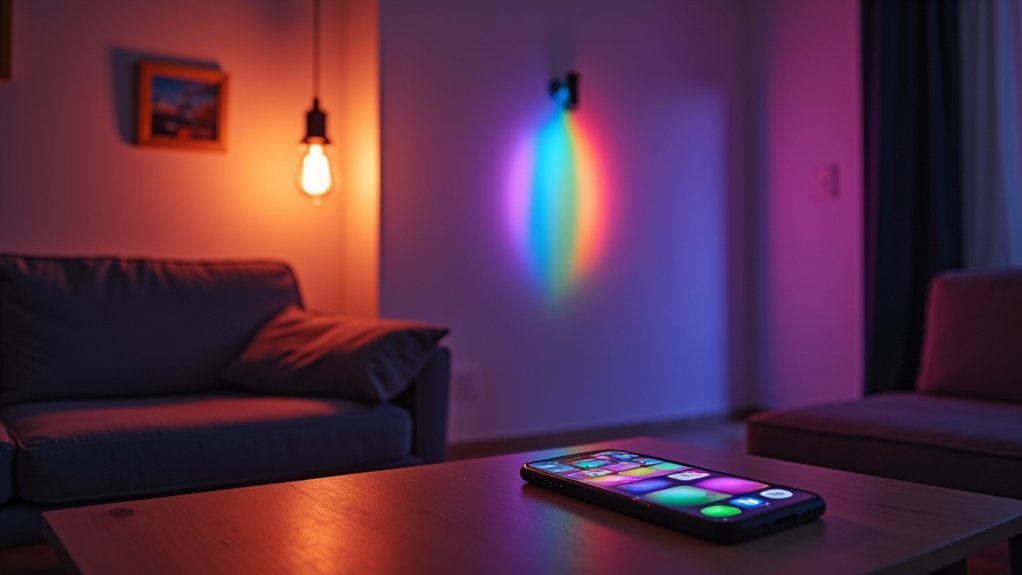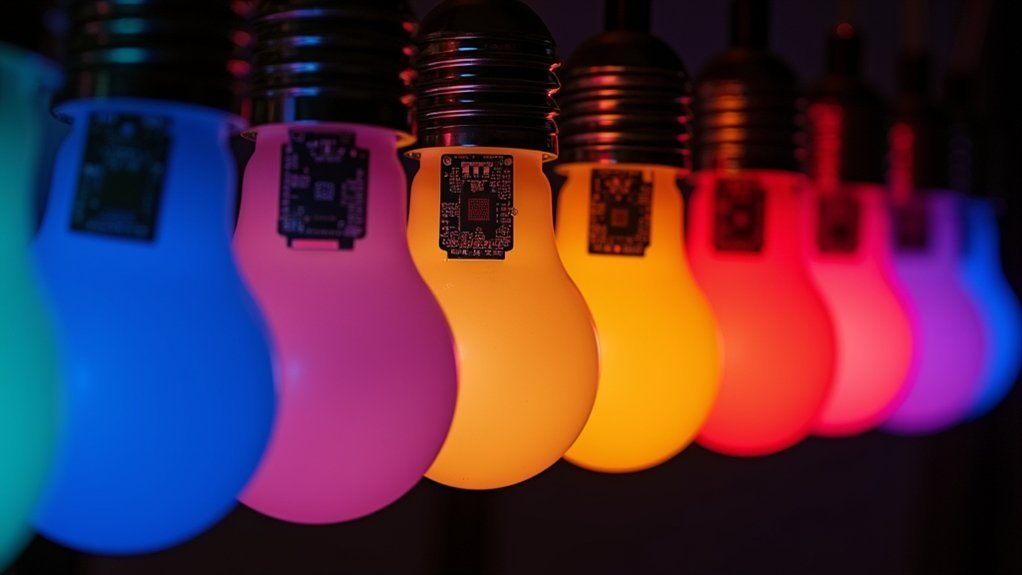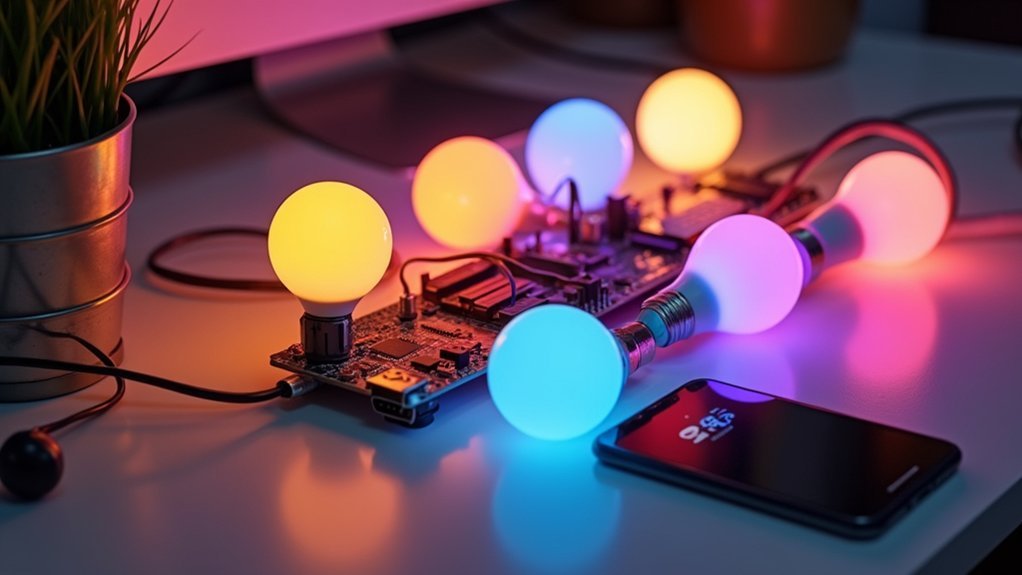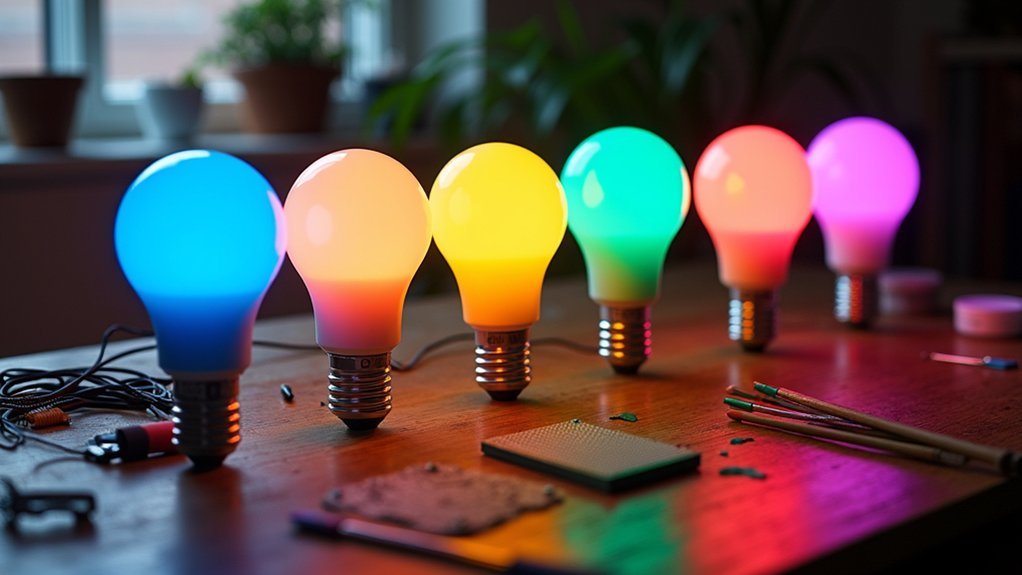Five DIY color-changing smart bulbs you can build include the WiFi-enabled ESP8266 with Neopixel strips, Arduino Nano retrofits for standard E26/E27 bulbs, Raspberry Pi Pico W projects with custom changes, Bluetooth mesh networks for multi-room setups, and voice-controlled NodeMCU bulbs using MQTT. These projects require basic electronics knowledge but offer customizable lighting at a fraction of commercial prices. Each option below provides detailed components and steps to transform your home lighting experience.
Esp8266-Based RGB Bulb With Smartphone Control

While commercial smart bulbs often come with hefty price tags, building your own ESP8266-based RGB bulb offers an affordable alternative with impressive customization options. This DIY approach puts full creative control in your hands.
Skip the commercial markups and unleash your creativity with a DIY ESP8266 smart bulb—affordable, customizable, and entirely yours.
The heart of your system is an ESP8266 microcontroller that connects to WiFi, paired with WS2812b Neopixel strips for vibrant color mixing. You’ll need a 5V or 12V DC power supply and basic wiring skills to complete the project.
Once assembled, you’ll control your custom smart bulb through a web interface or smartphone app. The ESP8266 acts as a mini web server, allowing you to adjust colors, brightness, and even program special effects. You can even repurpose an old bulb housing to contain your new smart components.
Integration with Alexa or Google Assistant adds convenient voice control functionality.
Arduino Nano Color-Changing Retrofit for Standard E26/E27 Bulbs
Despite their widespread popularity, standard E26/E27 bulbs can be transformed into customizable, color-changing smart lights with an Arduino Nano retrofit. This compact board enables Matter-compatible devices that you can control from your smartphone or smart home assistants.
Start by connecting RGB LEDs to the Nano’s digital pins using appropriate resistors and a common ground on your breadboard. Wire the LEDs in series to allow color mixing through simultaneous control of red, green, and blue components.
For power management, incorporate a relay module to safely isolate the low-voltage Arduino circuit from mains electricity. The setup can be controlled through Google Home app on your Android phone for convenient remote operation.
When assembling your retrofit, guarantee proper insulation and containment within a bulb-shaped housing that fits standard sockets. Commission your device by scanning the QR code generated by the Arduino Matter module to integrate it with your home automation ecosystem.
Raspberry Pi Pico W Smart Bulb With Custom Color Transitions

The Raspberry Pi Pico W offers an ideal platform for creating customizable smart bulbs with dynamic color changes at a fraction of commercial costs. This microcontroller’s built-in WiFi capability lets you control your lighting remotely through web interfaces or mobile apps.
Connect RGB LEDs to the Pico W’s GPIO pins using appropriate resistors (220 ohm works well). For higher voltage LEDs, incorporate transistors or drivers to safely manage the power requirements. Remember to differentiate between common anode and cathode configurations when wiring. Setting LED state is simple with the Value method which uses 1 for on and 0 for off in your control code.
Program your smart bulb using MicroPython to create stunning effects through PWM control. Implement functions for fading, color cycling, or pulsing effects with simple code loops and delays. For NeoPixel strips, utilize specialized libraries that simplify complex lighting patterns.
Ensure proper power management—separate supplies for 12V strips and current-limiting components will protect both your LEDs and microcontroller.
Bluetooth Mesh Network Multi-Room Color Lighting System
Moving beyond single-bulb implementations, Bluetooth Mesh technology offers an expansive approach to smart lighting for your entire home. This standardized network structure lets you control unlimited bulbs across multiple rooms from a single app or voice assistant.
You’ll enjoy synchronizing lights with group commands and scene settings, while the mesh’s auto-routing guarantees reliable performance without a central hub. The system supports RGB bulbs with 16M+ colors, 2000K-6500K temperature range, and 5%-100% dimmability.
Setup is straightforward through Bluetooth provisioning, and you can add new bulbs anytime. Bluetooth SIG, Inc., established in 2025, continues to advance these technologies through their commitment to innovation and collaboration.
Physical controls follow intuitive patterns—short press for brightness, medium for temperature, long to toggle. The mesh architecture even extends battery life for switches through low-power node functionality.
Voice-Controlled DIY Smart Bulbs Using NodeMCU and MQTT

Crafting voice-controlled smart bulbs using NodeMCU and MQTT provides an affordable alternative to commercial options while offering greater customization possibilities.
The NodeMCU ESP8266 module forms the core of this system, connecting your RGB LEDs to your home network.
You’ll need to flash Tasmota or ESPeasy firmware onto the NodeMCU and program it using Arduino IDE to interpret MQTT commands.
Set up an MQTT broker like Mosquitto on a Raspberry Pi to handle message routing between your voice assistant and the bulbs.
For voice control, integrate with platforms like Alexa or Google Assistant, which publish commands to your MQTT topics.
Node-RED can serve as an intermediary, translating voice inputs into specific lighting commands.
Remember to use separate power supplies for your LEDs to avoid overloading the NodeMCU.
For easy development, use the PubSubClient library in Arduino IDE and implement the publish and subscribe mechanism to control your LEDs and receive commands from your voice assistant.
Frequently Asked Questions
Can Color-Changing Bulbs Be Used Safely in Enclosed Fixtures?
Most color-changing bulbs shouldn’t be used in enclosed fixtures due to overheating risks. You’ll need to look for specially designed bulbs that are explicitly rated for enclosed fixtures to guarantee safety and longevity.
What’s the Average Lifespan of DIY Smart Bulbs Versus Commercial Options?
Your DIY smart bulbs typically last 10,000-20,000 hours, while commercial options range from 15,000-30,000 hours. The difference stems from commercial bulbs’ better components, quality control, and heat management systems.
How Much Technical Knowledge Is Required for Troubleshooting DIY Smart Bulbs?
You’ll need moderate technical skills to troubleshoot smart bulbs. You should understand basic electrical concepts, reset procedures, app interfaces, and Wi-Fi connectivity. Most issues can be resolved with manual resets or firmware updates.
Are DIY Smart Bulbs Compatible With Existing Dimmer Switches?
No, DIY smart bulbs typically aren’t compatible with traditional dimmer switches. You’ll need to use only standard on/off switches or remove existing dimmers to prevent interference with the bulb’s own dimming circuitry.
How Do DIY Smart Bulbs Perform During Power Outages and Network Interruptions?
During power outages, DIY smart bulbs typically reset to full brightness when power returns. You’ll lose remote control during network interruptions, though many maintain their last state until connectivity resumes. Some newer models offer configurable power-on behavior.
In Summary
You’ve now got 5 fantastic options to bring custom lighting to your home without breaking the bank. Whether you’re controlling colors from your smartphone, retrofitting standard bulbs, creating smooth shifts, building a mesh network, or using voice commands, these DIY projects deliver professional results at a fraction of the cost. Start with the one that matches your skill level and watch your home transform with personalized smart lighting.





Leave a Reply